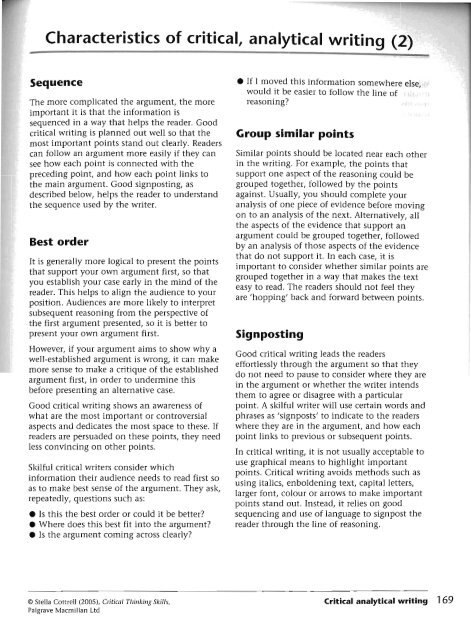Critical Thinking Skills - Developing Effective Analysis and Argument(2)
Critical Thinking Skills - Developing Effective Analysis and Argument(2)
Critical Thinking Skills - Developing Effective Analysis and Argument(2)
Create successful ePaper yourself
Turn your PDF publications into a flip-book with our unique Google optimized e-Paper software.
Characteristics of critical, analytical writinq (2)<br />
Sequence<br />
The more complicated the argument, the more<br />
important it is that the information is<br />
sequenced in a way that helps the reader. Good<br />
critical writing is planned out well so that the<br />
most important points st<strong>and</strong> out clearly. Readers<br />
can follow an argument more easily if they can<br />
see how each point is connected with the<br />
preceding point, <strong>and</strong> how each point links to<br />
the main argument. Good signposting, as<br />
described below, helps the reader to underst<strong>and</strong><br />
the sequence used by the writer.<br />
Best order<br />
It is generally more logical to present the points<br />
that support your own argument first, so that<br />
you establish your case early in the mind of the<br />
reader. This helps to align the audience to your<br />
position. Audiences are more likely to interpret<br />
subsequent reasoning from the perspective of<br />
the first argument presented, so it is better to<br />
present your own argument first.<br />
However, if your argument aims to show why a<br />
well-established argument is wrong, it can make<br />
more sense to make a critique of the established<br />
argument first, in order to undermine this<br />
before presenting an alternative case.<br />
Good critical writing shows an awareness of<br />
what are the most important or controversial<br />
aspects <strong>and</strong> dedicates the most space to these. If<br />
readers are persuaded on these points, they need<br />
less convincing on other points.<br />
Skilful critical writers consider which<br />
information their audience needs to read first so<br />
as to make best sense of the argument. They ask,<br />
repeatedly, questions such as:<br />
Is this the best order or could it be better<br />
Where does this best fit into the argument<br />
Is the argument coming across clearly<br />
If I moved this information somewhere else,<br />
would it be easier to follow the line of<br />
reasoning<br />
Croup similar points<br />
Similar points should be located near each other<br />
in the writing. For example, the points that<br />
support one aspect of the reasoning could be<br />
grouped together, followed by the points<br />
against. Usually, you should complete your<br />
analysis of one piece of evidence before moving<br />
on to an analysis of the next. Alternatively, all<br />
the aspects of the evidence that support an<br />
argument could be grouped together, followed<br />
by an analysis of those aspects of the evidence<br />
that do not support it. In each case, it is<br />
important to consider whether similar points are<br />
grouped together in a way that makes the text<br />
easy to read. The readers should not feel they<br />
are 'hopping' back <strong>and</strong> forward between points.<br />
Signposting<br />
Good critical writing leads the readers<br />
effortlessly through the argument so that they<br />
do not need to pause to consider where they are<br />
in the argument or whether the writer intends<br />
them to agree or disagree with a particular<br />
point. A skilful writer will use certain words <strong>and</strong><br />
phrases as 'signpostsf to indicate to the readers<br />
where they are in the argument, <strong>and</strong> how each<br />
point links to previous or subsequent points.<br />
In critical writing, it is not usually acceptable to<br />
use graphical means to highlight important<br />
points. <strong>Critical</strong> writing avoids methods such as<br />
using italics, enboldening text, capital letters,<br />
larger font, colour or arrows to make important<br />
points st<strong>and</strong> out. Instead, it relies on good<br />
sequencing <strong>and</strong> use of language to signpost the<br />
reader through the line of reasoning.<br />
D Stella Cottrell (ZOOS), <strong>Critical</strong> Tlrinking <strong>Skills</strong>,<br />
Palgrave Macmillan Ltd<br />
<strong>Critical</strong> analytical writing 1 69



